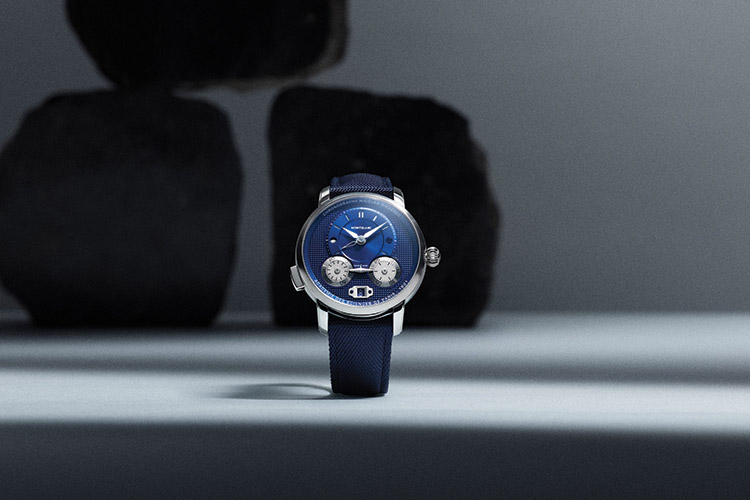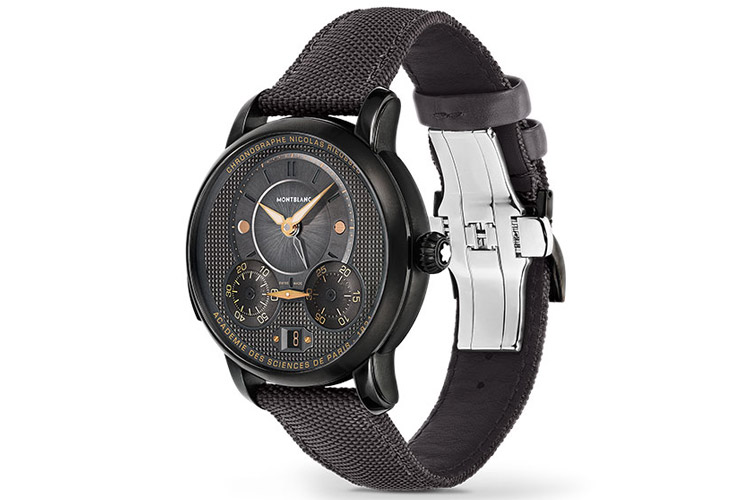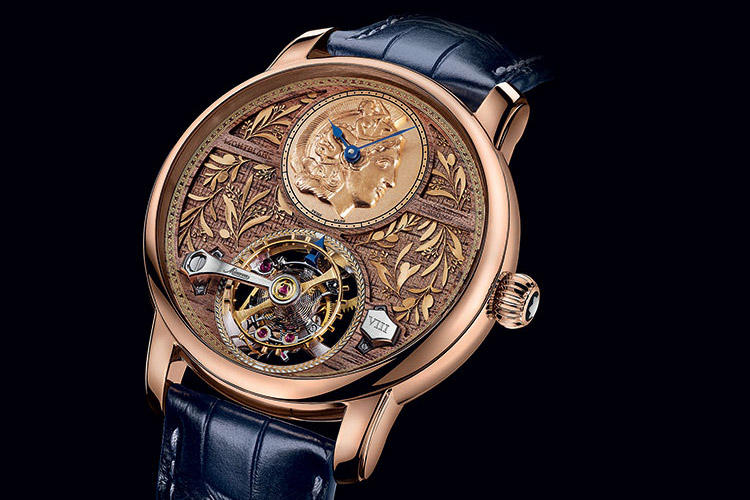Amazing editions of Star Legacy from Montblanc

Following the release of two new Montblanc Star Legacy Nicolas Rieussec Chronograph models in a smaller 43mm case size in 2022, Montblanc returns with two new contemporary interpretations this year. Additionally, in celebration of Minerva manufacture’s 165th anniversary, Montblanc is unveiling a brand-new Montblanc Star Legacy Suspended Exo Tourbillon Minerva limited edition of eight pieces
The first Montblanc Star Legacy Nicolas Rieussec Chronograph is a limited edition of 500 pieces in a stainless steel case with a black DLC coating and an anthracite dial, and the second, unlimited edition, comes in stainless steel with a deep blue dial with rhodium-coated hands and counters.
The story started on September 1, 1821, at Paris’s famous Champs-de-Mars horse racing track where Nicolas Rieussec was testing one of his latest inventions, a timekeeper designed to record the precise times of all the horses as they crossed the finish line. Nicolas Rieussec (1781-1866) was not only the sixth royal watchmaker to the King of France, he was also a businessman with an eye for opportunity. Horse races in Paris at this time were big business and being able to scientifically record the winners would be a gamechanger for the sport.
Nicolas Rieussec’s device worked using a fixed nib that would place a drop of ink on two rotating counters (one for the minutes, the other for the seconds) each time a horse crossed the finish line. His invention was a success and a few weeks later, he presented it to the Academy of Sciences in Paris, whose members were fascinated by the timing device and named it a “chronograph,” taken from the Greek word chronos for time and graphein to write. The word chronograph was born, and Nicolas Rieussec became the inventor of the world’s first inking chronograph, marking the history of fine watchmaking.
Fast forward to the modern day and the year 2007, Montblanc unveiled an intriguing wristwatch version of Nicolas Rieussec’s technology, featuring its first in-house movement. The configuration of Rieussec’s design was interpreted with two horizontally aligned chronograph counters, one for elapsed 60 seconds and the other indicating 30 minutes. Instead of each counter being static with its own rotating hand, the counters were the ones to turn, and a single index marker placed between the two counters indicated the elapsed time.
Over the years, Montblanc has presented an array of different iterations of the design with different materials, finishings and colours. This year, the classic timepiece returns with two new looks. One comes in a stainless steel case with a black DLC coating, anthracite-coloured dial, and rose gold-coated hands and indexes, while the second has been designed with a stainless steel case and a deep blue dial with rhodium-coated hands and indexes. Both new models feature several details that reinforce the historical Paris connection, where the story first began.
There are a number of elements that celebrate The City of Light. Firstly, there is a graphic Clous de Paris motif on the dial (replacing the previous Grain d’Orge design) a traditional design that originates from the geometric design of Paris’s cobbled streets. The motif, not uncommon in fine watchmaking, is continued onto the textile strap and the oscillating weight, which is quite unusual, and enhances the contemporary aesthetic of the timepiece.
Other modern details include open-worked indexes, dynamic dauphine hands with Super-LumiNova, baton indexes, a black semi-transparent sapphire crystal on the caseback, blued screws on the movement, and strong colour contrasts between the different elements on each dial. Completing the Paris connection, a mention in French of the “Académie des Sciences de Paris” is engraved on the flange, as a reminder that the academy validated Rieussec’s invention in 1821. The name “Chronographe Nicolas Rieussec” is also engraved at 12 o’clock.
The timepiece is powered by the self-winding Manufacture monopusher chronograph movement MB R200 that was the very first in-house movement by the Maison. Everything in the movement has been designed to reach a high level of technical efficiency and aesthetics.
It is equipped with a column-wheel that controls the monopusher mechanism. To improve the chronograph’s start, the connection between the gear train and the chronograph’s wheels is alternately engaged and disengaged by a vertical disc clutch and functions without any wear and tear. This mechanism prevents the elapsed time discs from jumping when the chronograph is switched on. The timepiece features a monopusher ergonomically positioned at 8 o’clock, where the wearer’s thumb can conveniently operate it.
Additionally, a rapid-reset mechanism for the hour and date is very practical for travellers who journey from one time zone to another. These indicators can be reset either clockwise or counter-clockwise without affecting the position of the minute-hand.
The rate is regulated by a large 10-mm-diameter balance wheel with screws, which oscillates regularly thanks to its high moment of inertia (12 mgcm²) and its frequency of 28,800 A/h (4 Hz). The stable rate is further enhanced by the double barrel, providing 72 hours of power reserve. Furthermore, the balance bridge is open-worked, ensuring the precise positioning of the oscillator for optimal shock resistance.
Montblanc Star Legacy Suspended Exo Tourbillon
In celebration of Minerva manufacture’s 165th anniversary, Montblanc is unveiling a brand-new limited edition of eight pieces. The dial of the Montblanc Star Legacy Suspended Exo Tourbillon Minerva 165 Years Limited Edition is made of walnut wood completely hand-engraved with a Roman frieze and includes olive leaves in gold applique. Continuing this bucolic theme, the suspended Exo Tourbillon is surrounded by a gold-engraved laurel tree. At 12 o’clock, a representation of Minerva’s profile has been depicted in gold. A total of around 82 hours of craftsmanship is required for this highly complicated and sophisticated dial.
Other details include a seconds hand represented by Minerva’s famous spear arrow, while the limited edition number VIII is engraved on a plate to the right of the suspended Exo Tourbillon at five o’clock, in Roman numerals. The timepiece comes in a 44.8 mm rose gold case with an open caseback and is fitted with a blue sfumato alligator strap.
This particular patented construction of the Suspended Exo Tourbillon allowed the watchmakers at the Montblanc Manufacture in Villeret to have a large and impressive balance wheel and eliminate the need to increase the size of the movement or the case. The large balance wheel is raised 3.2 mm higher than the dial and appears to be floating above it. This suspended position has been made possible thanks to a new engraving tourbillon bridge with only one stainless steel arm, which is curved and mirrors the domed hour circle at 12 o’clock, creating a three-dimensional look.
The patented mechanical architecture of the Exo Tourbillon saves more energy than a conventional tourbillon as the cage is smaller in size and free of the weight of the balance wheel. Another key feature of the Exo Tourbillon is the speed of its rotations. The cage completes one full rotation per minute, thus able to also indicate the seconds, while also inviting users to admire the beauty of the tourbillon’s movement.
The large balance wheel, beating at the traditional frequency of 18,000 oscillations per hour, has a diameter of 14.5 mm. The Manufacture movement calibre MB M16.68 is entirely decorated in the Montblanc Manufacture in Villeret with hand-crafted finishings such as Côtes de Genève stripes, inner angles, circular graining, bevelling and a mirror-polished pawl with the hand-finished Minerva arrow. Inspired by the three-dimensional bridge construction, the round shape of the case, with its domed sapphire crystal on the front, has been built around the movement, contributing perfectly to the overall design.








